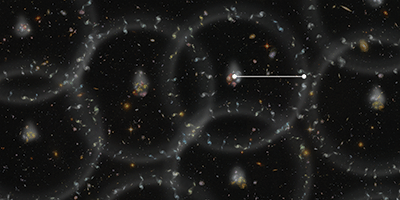Cosmic Ruler Measured More Directly
The clustering of galaxies forms faint “ripples” with a characteristic wavelength of about 450 million light years. This undulation, called the baryon acoustic oscillation (BAO) scale, gives cosmologists a sort of “ruler” with which to track the expansion history of the Universe by how its apparent size changes with time. A group of researchers has found a new way of estimating the BAO ruler that relies less on models of the distant past and more on observations of the relatively local Universe.
To measure the cosmic expansion, researchers use standard objects whose apparent size or brightness can reveal their distance from us. Certain supernovae, for example, are standard candles, whose brightness measurements gave the first indication that the Universe is accelerating. In order to confirm that acceleration, scientists have turned to other standards, such as the BAO ruler.
The BAO feature is considered to be the byproduct of sound waves traveling in the hot plasma of the early Universe. But to get a size estimate of the BAO scale, cosmologists have to rely on models of the plasma that are based on measurements of the cosmic microwave background. Alan Heavens of Imperial College London, UK, and his colleagues have come up with a more empirical way to find the BAO ruler length. They combine supernova data and galaxy data to determine the rate of expansion in the relatively recent past. From this, they obtain a BAO scale of 466 million light years, which agrees with previous determinations. The advantage of this new derivation is that it gives a number that any alternative cosmological model (e.g., one with no dark energy, or one with more neutrino species) would still have to reproduce.
This research is published in Physical Review Letters.
–Michael Schirber





